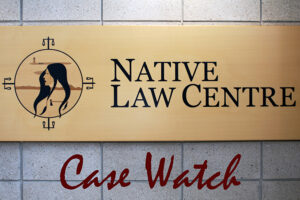FROM OUR PUBLICATIONS DESK

The following decisions came across our desk over the past month:
Equality rights of Métis children & families in child protection –
Catholic Children’s Aid Society of Hamilton v GH, 2016 ONSC 6287: The Ontario Superior Court of Justice released a decision in a Crown wardship application where it was found that the definitions of “Indian”, “Native person”, and “Native child” in Ontario’s Child and Family Services Act were invalid on the basis that they unjustifiably infringe s 15 of the Charter. The Court found that the impugned definitions do not extend to all individuals who self-identify as being Aboriginal. In fact, all parties conceded that they do not extend to Métis children. The Court also found that the Act afforded significant special protections for individuals falling into these definitions at every stage of a child protection intervention. The Court recognized that all Aboriginal peoples, including Métis, have been subject to a legacy of prejudice, stereotyping, and disadvantage. With this context in mind, the Court determined that the definitions created distinctions based on the analogous ground of “Aboriginality without membership in a community designated as “Native” under the [Act]”. It also concluded that these distinctions created or perpetuated disadvantage for Métis children and their families due to their inability to access the special protections under the Act. In conducting this analysis, the Court noted that the Act clearly created these unfair and objectionable disadvantages on its face and this could be discerned through logical reasoning alone. There was no need for social science evidence and empirical data. As no s 1 argument was advanced, the infringement was not saved. A suspended declaration of invalidity was issued and it was ordered that the Métis child in this case be treated as if he were an Indian, Native person or Native child within the meaning of the Act.
Inadequate investigation of vote-buying allegations by INAC –
Good v Canada (Attorney General), 2016 FC 1272: The Federal Court released a decision allowing in part an application for judicial review of INAC’s dismissal of an election appeal under the Indian Act. The applicant first unsuccessfully sought to appeal the March 2014 election of the Red Pheasant First Nation through INAC based on allegations of misconduct by the electoral officer and corruption in the form of vote-buying. She then sought judicial review of INAC’s rejection of that appeal. However, a subsequent election had since taken place in March 2016. The Court found that INAC’s delegate erred by choosing to dispense with any investigation of the applicant’s vote-buying allegations and proceeding to dismiss the appeal on the basis that corruption had not been proven on a balance of probabilities. The Court noted that this approach appears to have become settled practice within INAC’s Elections Unit. While the Court was sympathetic to INAC’s desire to streamline its management of appeals, it had significantly changed the very nature of the appeals process in a manner tantamount to attempting to amend the law via internal policy. The Court took no issue with how the delegate addressed the issue of electoral officer misconduct, but found that the delegate’s refusal to investigate conflicting evidence on vote-buying was unreasonable, based upon an error of law and procedurally unfair. While these issues were moot due to the subsequent election, the Court exercised its discretion to deal with the central controversy between the parties as roughly 40% of First Nations hold elections under the regime at issue in this case.
Relevance of Aboriginal equity stake to remedy in consultation case –
Michipicoten First Nation v Ontario (Minister of Natural Resources and Forests), 2016 ONSC 6899: The Ontario Superior Court of Justice dismissed an application for judicial review of provincial approvals for the Bow Lake Wind Farm Project on the shared traditional territory of the Michipicoten and Batchewana First Nations in northeastern Ontario. Michipicoten argued that the Crown breached its duty to consult and sought to quash the approvals, preclude further approvals until more consultation takes place, and have the court remain seized of remedies or order removal of the infrastructure, remediation of the lands, and costs. The Court noted that Michipicoten had inexplicably delayed several months in pursuing and perfecting its application for judicial review, which caused the proponent and Batchewana, which has a 50% interest in the project, serious harm. For this reason, the Court dismissed the application on its own motion. In the alternative, the Court went on to conclude that consultation was adequate as Michipicoten failed to provide any evidence of potential adverse impacts on its Aboriginal or treaty rights in spite of many requests to do so. Furthermore, the Court concluded that the remedy sought in terms of decommissioning the project was inappropriate. Michipicoten argued that a proponent’s commercial interests may not come into play in determining the balance of convenience in a consultation dispute between the Crown and an Aboriginal community. However, the Court found this principle inapplicable in this case since Batchewana would face irreparable harm if the relief sought was granted.
Validity of a Will under the Indian Act not providing for spouse –
Poitras v Khan, 2016 SKQB 346: The Saskatchewan Court of Queen’s Bench allowed an application for letters probate under a Will created pursuant the Indian Act. The testator met the man who became her husband and married him after she had already made her Will. Under provincial legislation, the testator’s spousal relationship would have automatically revoked her Will. However, the testator was a status Indian living on reserve and there was no such provision under the Indian Act to invalidate her Will automatically. Under the Indian Act, the Minister had the power to declare the Will void if it imposed hardship on persons to whom the testator had responsibility or was contrary to the interests of the band or the public. In this case, the Minister had referred the matter to the Court, conferring its power to declare the Will void on the Court. The testator’s husband, Mr. Khan, sought to invoke this power on the basis that he was not provided for in the Will. The Court confirmed the validity of the Will, but also noted that Mr. Khan could still potentially seek a claim for one half of the testator’s family property accrued from the date of marriage until death under provincial legislation.
Canadian Human Rights Tribunal’s jurisdictional limits re: Indian Act –
Beattie v Canada (Attorney General), 2016 FC 1328: The Federal Court dismissed an application for judicial review of a decision of the Canadian Human Rights Tribunal where a complaint was dismissed as being solely a challenge to legislation beyond the Tribunal’s jurisdiction. The applicant, Mr. Beattie, sought to register two leases and an assignment of lease in the Indian Lands Registry. The Registrar rejected the applications on the basis that the leases did not include the Crown as a party and no ministerial approval had been provided. Since the leases could not be registered, the assignment could not be registered either. As a result of this decision, the applicants brought a complaint to the Tribunal alleging that the respondent had discriminated against them on the basis of their race, national or ethnic origin by denying a service customarily available to the public. The Tribunal dismissed the complaints on the basis that they were beyond its jurisdiction since they were challenging the Indian Act itself, which obliged the Registrar to reject the leases and assignment. The Court was satisfied that the Tribunal’s decision was reasonable and it was reasonable to rely on other Federal Court and Tribunal decisions where such challenges to legislation were dismissed as beyond the Tribunal’s jurisdiction. The Court also rejected the applicants’ assertion that title to the reserve lands at issue in this dispute were vested in an individual pursuant to either a Certificate of Possession or customary tenure.
Court’s duty to explicitly consider & inquire into Gladue factors –
R v Park, 2016 MBCA 107: The Manitoba Court of Appeal allowed an appeal from sentence for impaired driving and drug possession due in part to the sentencing judge’s failure to adequately consider Gladue factors. It was conceded that defence counsel during the sentencing hearing did not address Gladue factors other than to note that the accused was Aboriginal. No Gladue report was ordered. The Crown argued that defence counsel expressly waived the Gladue rights of the accused whereas counsel for the accused on appeal argued that the Court had a duty to make further inquiry when no advocacy was provided on Gladue factors during sentencing. The Court of Appeal found there was no express waiver in this case. Defence counsel at sentencing acknowledged there were Gladue factors but focused on other arguments. A waiver must be express and clear. Both defence and Crown counsel have an obligation to bring forward Gladue information. Where that does not happen, the Court may need to go further and has a duty to at least make further inquiries. The Court must also make explicit its consideration of Gladue factors and its determination that it has adequate information on those factors before it. It is unsatisfactory for both the offender and the public to have to infer such circumstances were properly considered. The sentencing judge failed to expressly confirm that Gladue factors were considered and failed to clarify defence’s reliance on Gladue, which in turn had an impact on the sentence. The sentence was varied.
No need for ‘linkage’ between Gladue factors & offence –
R v Predham, 2016 ABCA 371: The Alberta Court of Appeal allowed an appeal from sentence with respect to convictions for driving while disqualified, breach of recognizance, failure to appear and possession of a stolen licence plate. The appellant argued that the sentencing judge erred in failing to give appropriate weight to his Gladue factors, among other things. In particular, the appellant took issue with the sentencing judge’s reasons where it was suggested that Gladue factors were less relevant to the offence of driving while disqualified in the absence of alcohol, drugs or violence. The sentencing judge stated that there must be “some relationship between the Gladue factors and the offending in order for there to be that sort of linkage”. The Court of Appeal held that it was an error of law to require a linkage between Gladue factors and the offending conduct. The Court stated that it is also an error to carve out a certain category of offences as being immune from the Gladue analysis. The Court was also satisfied that the sentencing judge’s error influenced his ultimate decision. The sentence was varied.
Injunction against Cleveland baseball team’s name & logo denied –
Cardinal v Major League Baseball, 2016 ONSC 6929: The Ontario Superior Court issued its reasons for dismissing an urgent interim injunction application to restrain the Cleveland baseball team, Rogers Communications, and Major League Baseball (MLB) from displaying the team’s name or logo during a game in Toronto and while the underlying federal and provincial human rights complaints proceed. In the underlying complaints, the applicant, Douglas J. Cardinal, is alleging that the use of the team’s name and logo constitutes prohibited discrimination and harassment against him on the grounds of race, ancestry, colour, ethnic and national origins, and constitutes a publication or display intended to incite infringement of the Ontario Human Rights Code. The Court held that it had jurisdiction over the application, rejecting MLB’s argument that it ought to allow the United States Supreme Court to determine the underlying issues in this case based on principles of comity. The Court was also satisfied that the parties raised serious issues to be tried in terms of whether a service had been offered and whether the team’s name and/or logo offend the provisions of federal and Ontario human rights legislation, as well as the relevance of MLB’s freedom of expression to the dispute. However, the Court did not accept the applicant’s assertion that he would sustain irreparable harm if an injunction was not granted, noting that damages were available and disputes over use of the impugned name and logo have been ongoing for years. The Court noted that the applicant sought a change to the status quo and his last minute application, if granted, would materially prejudice the respondents. The issue of delay went to both the question or irreparable harm and the balance of convenience.
Settlement approved in Newfoundland & Labrador school claims –
Anderson v Canada (Attorney General), 2016 NLTD(G) 179: The Newfoundland and Labrador Supreme Court approved the terms of a $50 million settlement in a class action brought by Aboriginal individuals who attended schools, dormitories or orphanages in the province between 1949 and 1980. The plaintiffs claimed that Canada breached a fiduciary duty to the students who attended these facilities to protect them from actionable physical or mental harm. The Court was satisfied that the settlement was fair, reasonable, made in good faith, and in the best interests of the class as a whole. It was also satisfied that the fees and disbursements of the plaintiffs’ counsel were fair and reasonable. The settlement includes both General Compensation Payments for years that students resided at the facilities at issue, and Abuse Compensation Payments that depend on the harm individual students suffered. The settlement provides for a confidential paper-based claims process and Canada is committed to funding mutually agreeable commemoration and healing initiatives over and above its compensation funding.
Tax Court’s exclusive jurisdiction over tax assessment challenges –
Horseman v Canada, 2016 FCA 252: The Federal Court of Appeal dismissed an appeal from a decision to strike the appellant’s claims as falling under the exclusive jurisdiction of the Tax Court of Canada. The appellant received a Notice of Assessment and Requirement to Pay $59,000.06 of outstanding GST. He initiated this Federal Court action for a declaration that the Requirement to Pay is null and void and contrary to the Indian Act, Treaty No. 8, and s 35 of the Constitution Act, 1982. The Court found that this challenge was properly characterized as an indirect challenge to a tax assessment, making it plain and obvious that the Tax Court had exclusive jurisdiction. The Tax Court has jurisdiction to consider the constitutional validity, applicability or operability of federal legislation and regulations and can issue remedies if a notice of constitutional question is properly served. It is also well-established that the Tax Court can determine claims under s 87 of the Indian Act over the applicability of tax requirements, or involving tax exemption claims under Treaty No. 8. Such assertions are properly tested in the Tax Court.
Provincial human rights tribunal’s jurisdictional limits re band store –
Dinsmore v Slenyah Store, 2016 BCHRT 176: The British Columbia Human Rights Tribunal dismissed a human rights complaint alleging discrimination in the area of employment on the basis of colour or race with respect to a business in Fraser Lake, British Columbia known as the Slenyah Store. The business was operated by the Stellat’en First Nation up until April 2014. The majority of its customers are status Indians who are able to purchase gas and cigarettes at tax exempt rates there. In 2013, the store was in serious financial difficulty. It was kept afloat via overdraft protection from Stellat’en and Stellat’en paid the store’s back taxes to get it out of its financial difficulties. In 2014, the store was incorporated to be operated at arm’s length through a limited partnership. As a result of these changes, all the store’s employees were laid off by Stellat’en and encouraged to reapply for positions with the limited partnership that would operate the store going forward. The Tribunal found that while the store was operated by Stellat’en it was an integral part of the First Nation’s overall governance and operations. Its purpose was to permit members to avail themselves of their tax-free status, it was financially integrated with the First Nation, its employees were employees of the First Nation, and its operations were continuously concerned with the status, rights and privileges of Stellat’en’s members. As a result, the store fell under federal jurisdiction and outside the Tribunal’s jurisdiction while it was operated by Stellat’en. While operated at arm’s length through a limited partnership, however, the store was a provincial undertaking subject to the Tribunal’s jurisdiction. The Tribunal went on to dismiss the complaint against both entities on the ground that it had no reasonable prospect of success if it were to proceed on its merits.
__________________________________________________________________
This Case Watch blog post has been brought to you by the Native Law Centre in partnership with Pro Bono Students Canada – University of Saskatchewan





